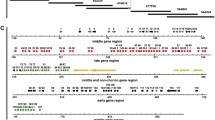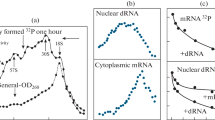Abstract
The chorion (eggshell) of silkmoths consists of more than 100 distinct proteins. Individual components are synthesised in characteristic and overlapping sequence, at early, middle, late or very late developmental periods of choriogenesis (which lasts 2 days in total)1,2. Protein sequencing3,4 indicates that components which belong to two size classes, A and B, are encoded by two respective families of evolutionarily homologous genes (multi-gene families). Genetic analysis in Bombyx mori5,6 has shown that chorion genes are tightly linked in three clusters on a single chromosome (n = 28). Total chorion mRNA of the wild silkworm, Antheraea polyphemus, has been copied into double-stranded cDNA and cloned by recombinant DNA procedures7. Many distinct cDNA clones have been selected and identified as members of the A and B multi-gene families by detailed cross-hybridisation7 and sequencing8 analysis. Stringent conditions which minimise cross-hybridisation permit use of these clones as specific probes. In many cases, we know the protein encoded and the developmental period when the clone sequence can be found in cytoplasmic RNA7,8. Thus, we may now use these cDNA clones as probes to determine how genes of known developmental properties and evolutionary history are arranged within the chorion chromosomal region. We report here that two cloned, 14-kilobase chromosomal DNA segments contain multiple chorion genes. In each segment, the genes represent both A and B families, but only one developmental class: one segment contains only middle-period A and B genes and the other only late-period A and B genes. In both segments, members of the two families are arranged in alternating sequence and divergent orientation.
Similar content being viewed by others
References
Kafatos, F. C. et al. in Results and Problems in Cell Differentiation Vol. 8 (ed. Beerman, W.) 45–145 (Springer, Berlin, 1977).
Paul, M. & Kafatos, F. C. Devl Biol. 42, 141–159 (1975).
Regier, J. C., Kafatos, F. C., Goodfliesh, R. & Hood, L. Proc. natn. Acad. Sci. U.S.A. 75, 390–394 (1978).
Rodakis, G. C. thesis, Univ. Athens (1978).
Goldsmith, M. & Basehoar, G. Genetics 90, 291–310 (1978).
Goldsmith, M. & Clermont-Rattner, E. Genetics 92, 1173–1185 (1979).
Sim, G. K. et al. Cell 18, 1303–1316 (1979).
Jones, C. W., Rosenthal, N., Rodakis, G. C. & Kafatos, F. C. Cell 18, 1317–1332 (1979).
Maniatis, T. et al. Cell 15, 687–701 (1978).
Blattner, F. R. et al. Science 196, 161–169 (1977).
Benton, W. D. & Davis, R. W. Science 196, 180–182 (1977).
Southern, E. M. J. molec. Biol. 98, 503–517 (1975).
Kafatos, F. C., Jones, C. W. & Efstratiadis, A. Nucleic Acids Res. 7, 1541–1552 (1979).
Lifton, R. P., Goldberg, M. L., Karp, R. W. & Hogness, D. S. Cold Spring Harb. Symp. quant. Biol. 42, 1047–1051 (1977).
Kedes, L. H. Cell 8, 321–331 (1976); A. Rev. Biochem. 48 (in the press).
Mirault, M.-E., Goldschmidt-Clermont, M., Artavanis-Tsakonas, S. & Schedl, P. Proc. natn. Acad. Sci. U.S.A. 76, 5254–5258 (1979).
Holmgren, R., Livak, K., Morimoto, R., Freund, R. & Meselson, M. Cell 18, 1359–1370 (1979).
Royal, A. et al. Nature 279, 125–132 (1979).
Fritsch, E. F., Lawn, R. M. & Maniatis, T. Nature 279, 598–603 (1979).
Bernards, R., Little, P. F. R., Annison, G., Williamson, R. & Flavell, R. A. Proc. natn. Acad. Sci. U.S.A. 76, 4827–4831 (1979).
Lacy, E., Hardison, R. C., Quon, D. & Maniatis, T. Cell 18, 1273–1283 (1979).
Tilghman, S., Curtis, P., Tiemeier, D., Leder, P. & Weissmann, C. Proc. natn, Acad. Sci, U.S.A. 75, 1309–1313 (1978).
Kinniburgh, A. & Ross, J. Cell 17, 915–921 (1979).
Yamamoto, K. R. & Alberts, B. M. A. Rev. Biochem. 45, 721–746 (1976).
Ashburner, M. & Bonner, J. J. Cell 17, 241–254 (1979).
Otsuka, A. & Abelson, J. Nature 276, 689–694 (1978).
Arst, H. N. & MacDonald, D. W. Nature 254, 26–34 (1975).
Lewis, E. B. Nature 276, 565–570 (1978).
Author information
Authors and Affiliations
Rights and permissions
About this article
Cite this article
Jones, C., Kafatos, F. Coordinately expressed members of two chorion multi-gene families are clustered, alternating and divergently orientated. Nature 284, 635–638 (1980). https://doi.org/10.1038/284635a0
Received:
Accepted:
Issue Date:
DOI: https://doi.org/10.1038/284635a0
- Springer Nature Limited
This article is cited by
-
The B multigene family of chorion proteins in saturniid silkmoths
Journal of Molecular Evolution (1983)
-
Human chorionic gonadotropin β-subunit is encoded by at least eight genes arranged in tandem and inverted pairs
Nature (1982)
-
Assignment of snRNA gene sequences to the large chromosomes of rat kangaroo and Chinese hamster isolated by flow cytometric sorting
Chromosoma (1982)
-
The structure of one of the eight or more distinct chromosomal genes for human interferon-α
Nature (1980)





